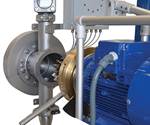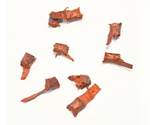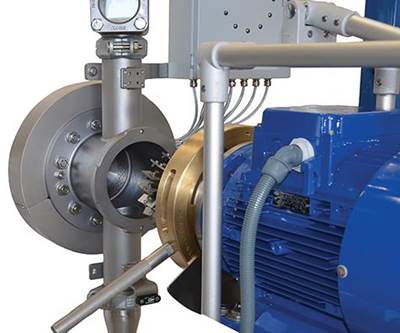With today’s increasing use of complex or novel material formulations and the steady tightening of efficiency goals, it becomes ever more challenging to achieve high-quality pellets. The trend is a major driver in our industry’s evolution from strand to underwater pelletizing (UWP). This transition, however, can be daunting. Initially, UWP equipment can be intimidating, and uninformed decisions can lead to costly quality issues and equipment damage. Preventing some of these troubles and dealing with those that do arise requires a combination of partnering with your UWP supplier and being aware of troubleshooting guidelines for common problems.

Pellets made by underwater pelletizers should be spherical in shape.
Step 1. Preparation & Partnership
Relationships with your suppliers are always important, but in the case of UWPs, the relationship is critical. Compared with strand pelletizers, UWPs are more elaborate and more sophisticated. There is a steeper learning curve, and knowledge is key. The leading pelletizer suppliers have very different philosophies on how the technology should be made actionable on the shop floor. Therefore: Know your pelletizer supplier, and make sure the supplier knows you.

Compounders should align with underwater pelletizer suppliers that can keep them up to date with the latest technologies, as these are not general-purpose tools.
Make sure your supplier plays its part. It should be an UWP supplier’s goal to proactively navigate quality issues and bridge that knowledge gap by partnering with processors to provide actionable and reliable guidance. A “partnered” UWP supplier will also keep you up to date on new technologies advantageous to your operation. This customer/supplier relationship may seem a strange place to start discussions of underwater-pelletizing troubleshooting, but it has a huge impact on technical knowledge management and ability to complete rudimentary to mid-level UWP troubleshooting.
Know your pelletizer supplier, and make sure the supplier knows you.
Step 2. Balancing Application Specs with Equipment Scope and Cost
Balance is a key attribute of any well designed and efficient process, and pelletizing is no exception. In order to maximize line performance and quality, pay particular attention to the performance specification. UWPs are the most versatile form of thermoplastic pelletizer, but too often they are treated as a general-purpose tool. Many shops do so with fair success, but they often sacrifice throughput, pellet quality and efficiency. Balanced partnering between customer and UWP supplier is necessary to identify and align critical products, formulations, and throughput with the appropriate equipment and options, while minimizing cost to the customer.
In short, the supplier should not oversell, and the customer should realize that quality starts with an appropriately designed process. This part of the process falls apart when the technical specification is larger than the budget. A solid relationship with your UWP supplier can help you with early budgetary quotes, allowing the chance to better manage expectations and build realistic and predictive financial models.

The design of the pelletizing die is critical and must be tuned to the materials being run.
Die design is one of the most critical aspects of the process and it is important to have the die correctly tuned to your materials. Key factors are:
• Die pressure;
• Throughput rate;
• Viscosity;
• Pellet specification (g/100 pellets).
Step 3. Commissioning and Performance Optimization
“A good start is half the job.” It all comes together in implementation and startup. Now you are most likely dealing with a field-service engineer, who is a critical component of pellet quality and line performance. The field-service engineer makes sure the line is installed and functioning correctly. This is also the person that initially trains your staff on the UWP and supporting auxiliary equipment. For the training to be effective the field-service engineer will:
• Thoroughly explain the function and conduct training on the mechanical aspects of the UWP.
• Run and establish processes for your core products/formulations (80/20 rule).
• Review the spare-parts list for the system and recommend the critical parts that need to be kept on site.
• Train the maintenance staff to ensure the equipment runs efficiently.
A good UWP supplier will also schedule follow-up visits to evaluate the effectiveness of the training and product quality. Keep in mind that the overall optimization process and training could take several visits, but this process is necessary to minimize issues and troubleshooting in the future. Despite the best planning, equipment and execution, there will always be quality and process issues. The goal to this point has been to minimize these issues.
Step 4. Common Problems & Solutions on the Floor
If the process has been well defined by the customer and UWP supplier, defects will be minimal and relatively easy to troubleshoot. The most common defects and likely solutions are outlined below:
Irregular pellet shapes: This is the most common quality issue in pelletizing. UWP pellets should have a spherical shape. Often customers experience inconsistent sizes or flat or football-shaped pellets. These problems can be caused by feed issues, obstructions blocking the die hole, or material solidifying or freezing in the die plate.

Irregularly shaped pellets can be caused by feed issues, obstructions blocking the die hole, or material solidifying or freezing in the die plate.
To solve this issue, make sure there is no surging from the feeders into the extruder and that they are feeding at the correct rate. A common problem in recycling is that impurities are not properly filtered from the melt. This can lead to holes being blocked, so the melt filtration may need to be checked.
A common problem on recycling is that impurities are not properly filtered from the melt.
Die freeze can be addressed in several ways. Make sure all the die heaters are working and are able to maintain the proper temperature setpoint. An open-hole calculation can be used to check the number of holes actually open based on parameters such as cutter speed, number of blades on the cutter hub, the number of unplugged holes in the die plate, the throughput rate, and the pellet weight. The calculation is below:
Number of open holes = (16.67 × production rate (kg/hr)) / (weight per pellet (g) × number of cutter blades × number of unplugged holes in the die plate).
Plugging holes in a die plate is a common way to optimize the equipment based on the current production conditions.
It is also important to check the melt temperature of the polymer and the temperature of the process water. If either of these temperatures are too low, the polymer is more likely to solidify in the die plate.
Tails and Fines: Tails are small pieces of plastic that can be formed when the pellet is not cut cleanly. As the pellets flow into the dryer, this piece of plastic can break off and get into the process water. When separated from the pellet, tails become fines.

Tails and fines are produced when the pellet is not cut cleanly.
Filtration of the process water is important to make sure there are no process disruptions, but ideally, tails and fines should not be generated. They are prevented by making sure the die face is in good condition. It may require having the die face ground to remove any grooves in the die plate. Maintaining the blades will also help to eliminate tails on the pellets. Most pelletizer manufacturers have self-sharpening blades and maintenance can be done while the pelletizer is in operation.
Agglomerates: Agglomerates are large chunks of plastic that are commonly formed at startup of the pelletizer, but could also be formed due to an upset condition in the system. These large pieces can damage the internal parts of the centrifugal dryer. When starting an underwater pelletizer, it is important to have material coming out of the die plate, water coming across the die face, and the pelletizer starting in a closely timed sequence. If material arrives before the pelletizer starts, agglomerates can form.

Agglomerates are large chunks of plastics that are commonly formed at start-up.
Pelletizer suppliers know how critical these startup parameters are and have controls in place to avoid the formation of agglomerates. The field-service engineer will properly adjust the control system during commissioning.
Doubles/Chaining: When pellets don’t cool adequately, they can stick to each other. If several pellets stick together at once, this phenomenon is known as chaining.
To address this issue, it is important to make sure the process water is at the correct temperature. If the water is too hot, it will not properly cool the pellets as they are cut. Another parameter to check is the melt temperature. If it’s too high, this has the same effect as the process water being too hot, and the pellet cannot properly cool. Making sure there is sufficient process-water flow can also help to address chaining.
Your relationship with your UWP supplier is the real key to success in mitigating and troubleshooting performance and pellet quality issues. They are expert guides through tough technical waters.
ABOUT THE AUTHOR: Merritt Christian joined Nordson in 2016 as market development manager, pelletizing (Americas). Since 1989, he has held positions as technical-service engineer and lab manager for Amoco, PolyOne, and DSM before becoming DSM’s market and application development engineer. In 2010 Christian joined Sukano Polymers as operations manager and later became v.p. of technology. He also spent four years at SK Chemicals America, where he oversaw business development for Advance Polymer Solutions. Contact: 404-764-0001; merritt.christian@nordson.com; www.nordsonpolymerprocessing.com.
Related Content
How to Configure Your Twin-Screw Extruder: Part 3
The melting mechanism in a twin-screw extruder is quite different from that of a single screw. Design of the melting section affects how the material is melted, as well as melt temperature and quality.
Read MoreThe Path to Pellet Perfection
In underwater pelletizing, numerous variables in the equipment, process and material affect pellet shape, consistency and quality factors such as fines. Defining the “perfect” pellet depends on the conditions of end use, and achieving that ideal requires understanding of the causes of imperfections.
Read MoreSmall Batches, Big Success
With no minimum order and an impeccable record of on-time delivery, Precision Color Compounds is becoming a force in the color masterbatch business.
Read MoreHow to Configure Your Twin-Screw Barrel Layout
In twin-screw compounding, most engineers recognize the benefits of being able to configure screw elements. Here’s what you need to know about sequencing barrel sections.
Read MoreRead Next
Solving Common Problems in Underwater Pelletizing
Pellet quality and consistency are critical to any compounding operation. But in underwater pelletizing, a variety of issues can stand in the way. Here’s how to fix them.
Read MoreSolve Seven Common Pelletizing Problems
Here's a quick how-to on keeping your pelletizing line churning out quality product.
Read MoreFollow These Guidelines to Select the Right Pelletizing System
Which pelletizing system is right for your application? Is the one you’re using today necessarily the right choice for tomorrow? Here’s is an analysis that can help you decide among the three major options.
Read More






























